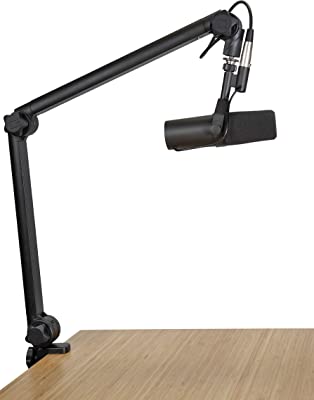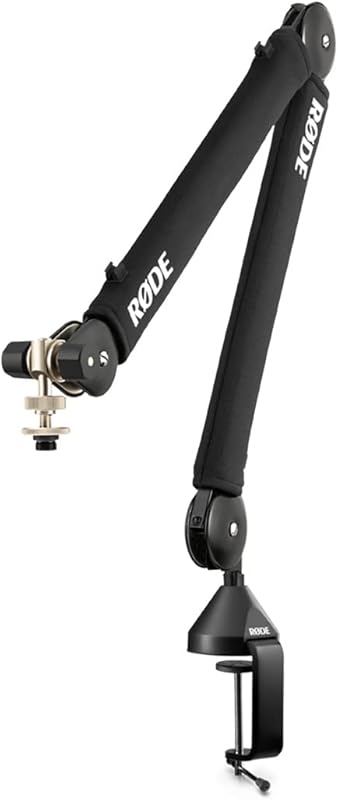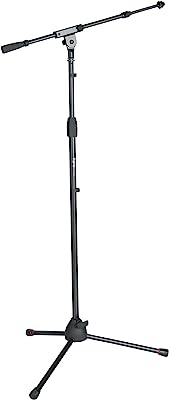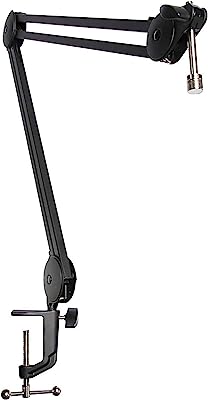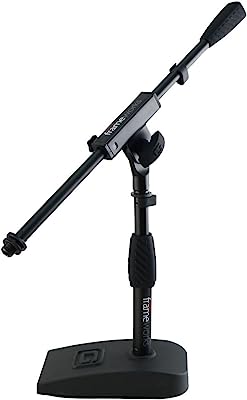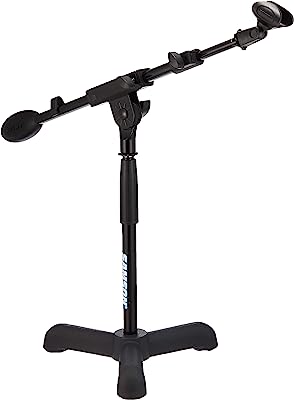This year I attended a panel discussion at NAMM about the future of the music industry.
One of the panelists said something that really caught my attention: pretty soon, we'll all be doing everything live from our broadcast channels.
There will be no recordings, just performances. Then, if somebody wants to keep your song, you can sell a copy as an NFT.
Honestly, we're already kind of there. I mean, right now as I'm typing this, I'm looking at all the mini boom stands and microphones I have in my studio. Between social media, podcasts, TikTok, and Zoom, we're constantly broadcasting in some way or another as musicians. And a good mic stand is key to sounding your best.
Top 3 - Boom Mic Stands / Arms
That's why it's super important to check out the best boom mic stands and desk boom arms on the market. Here are a few choices for different situations.
The Best Boom Mic Stands & Desk Boom Arms
1. Gator Frameworks Deluxe Desktop Mic Boom Stand
Gator is an awesome company that makes great instrument cases and mic stands. I use some of their products and appreciate the attention to detail they put into them.
For example, the Gator Frameworks Deluxe Mic Boom Arm has a 360° rotation adjustment, which is great for interviews. If I'm doing a live video or video conference, I can easily shift the mic from myself to the artist or guest. Plus, the stand comes with a 10' XLR cable threaded internally to keep it tidy and professional-looking.
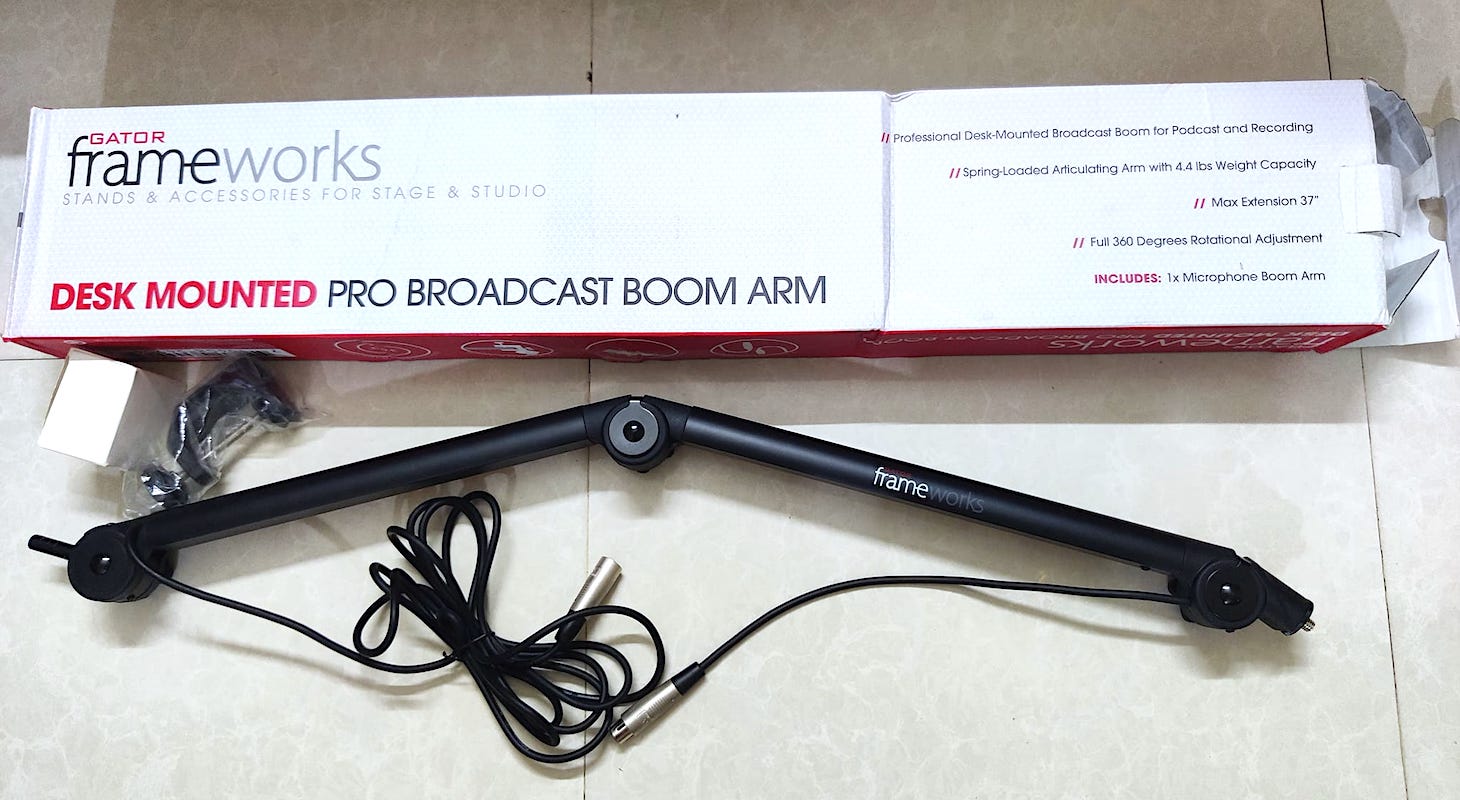
Gator Deluxe Boom Arm
It's also important to have an arm that can handle heavier microphones. Sometimes, I use my desk mount stand to record song ideas on the spot or for demos with vintage mics like a Neumann M149. These mics have some weight to them, so a sturdy arm stand is necessary.
The only downside to this particular desk-mounted boom arm is that the elbow is a bit too stiff. Even after a lot of use, I still feel like I might break it. I assume this is to keep the stand from tipping forward during use, but I've had to use some WD-40 in the past to loosen it up a bit.
2. Rode PSA1+ Professional Studio Boom Arm
The Rode PSA1+ is perfect for those Insta videos of performances because it can stretch out to about 37 inches. That way, you can put it up above your head and out of the shot but still pick up all that sweet ambient noise from specific instruments, especially percussion.
Sometimes you just don't want to use your computer speakers or a lapel mic and instead want the mic out of the shot while you're talking but still get that crisp, clear sound.
I could feel the difference in construction quality compared to the original PSA1. It now supports much lighter mics (minimum 94g now as opposed to around 700g for the outgoing model).
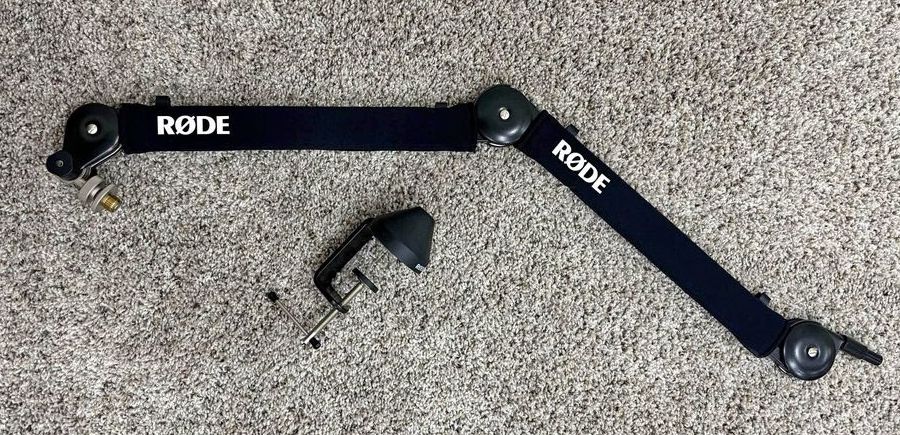
Rode PSA1+
Now, it doesn't actually come with an XLR cable, but it does have a hook and loop to keep your XLR cable nice and neat.
It's way better to use your own XLR cable anyway since the ones that come with it aren't necessarily pro-grade like Mogami or Monster. Plus, the boom arm comes with an adapter that extends the clamp so it's super easy to attach it to most tables and surfaces.
Just keep in mind that when you're using this desk boom arm, you want to make sure your table is thick enough to handle it.
It works with reinforced studio tables that may be thicker than most boom arms. One of the major issues with the older generation (PSA1) was that if you were moving it around while recording, it used to get a little noisy and squeaky, which caused some static that nobody wants. This is contained to a great extent in the newer model, thanks to the improved rubber contact points.
3. Gator Frameworks Tripod Mic Stand with Boom
This is a tripod stand for microphones that has a boom arm that can be extended. I use the Gator Frameworks Tripod a lot to pick up the sound of a room for drums and percussion.
This stand is designed to have a sturdy telescoping arm that can reach deep into the lid of a grand piano or the back of an upright piano against the wall.
Many stands with boom arms that can be extended are not strong enough to support much weight, causing the microphone to fall and hit cymbals or piano strings. This can cause real damage to the instrument and microphone, and also create a loud noise while recording.
So, it's super important to choose a tripod stand with a strong elbow clasp and telescoping boom arm. The Gator stand uses a rugged steel twist clutch that locks the microphone securely in place.
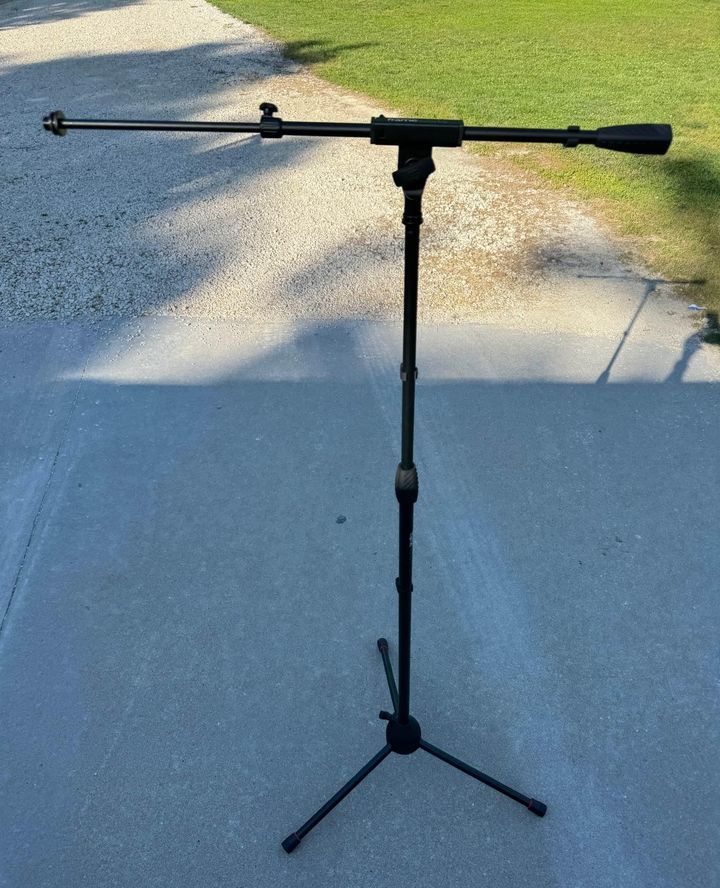
Gator Tripod Mic Stand with Boom - it's sturdy enough for outdoor use!
This is also a great microphone stand for making social media videos when you're performing on a synthesizer or away from your desk. It's tall enough to position the microphone above your head with a GoPro or small clip for your iPhone, allowing you to capture aerial video of your performance.
Personally, I like to use a squid attachment that wraps around the telescoping boom to set up my iPhone at interesting angles and capture my keyboard performance.
4. On-Stage Stands Professional Studio Boom Arm
On-Stage manufactures stands for keyboards, microphones, and studio equipment. Their MBS7500 is a microphone boom designed for broadcasting.
I have to say, I love how On-Stage keeps it simple with its design. You only see a thin arm and elbow because all the parts are inside. This is perfect for modern-looking places.
I tried the On-Stage and it was super quiet. We've all been in situations during video chats or podcasts where you might need to move the microphone around. If it's too noisy or causes static because of uneven weight distribution, it's not going to work out, especially if you're already broadcasting live. This is a reliable stand to use to avoid any of those awkward moments.
One issue I had with the On-Stage was that it couldn't properly hold my Neumann M149. It started drooping after about 20 minutes. Even though the Neumann is heavy, the specs say it should work, so I'm not exactly sure why this happened.
Anyway, if you're using a simple broadcasting mic or a dynamic mic like the Shure SM7B or SM58 and sitting at your desk, you shouldn't have any problems. I recommend it as a vocal mic for talkback to your isolation room or for quick idea recording. It's simple and doesn't clutter a small workspace table.
5. Gator Frameworks Compact Amp Mic Stand
The Gator Frameworks Amp Mic Stand is really strong and works great. The Stand is another simple but effective design by the Gator guys. You need a durable and stable kick drum mic stand because it's going to get hit hard by the drummer's kicks.
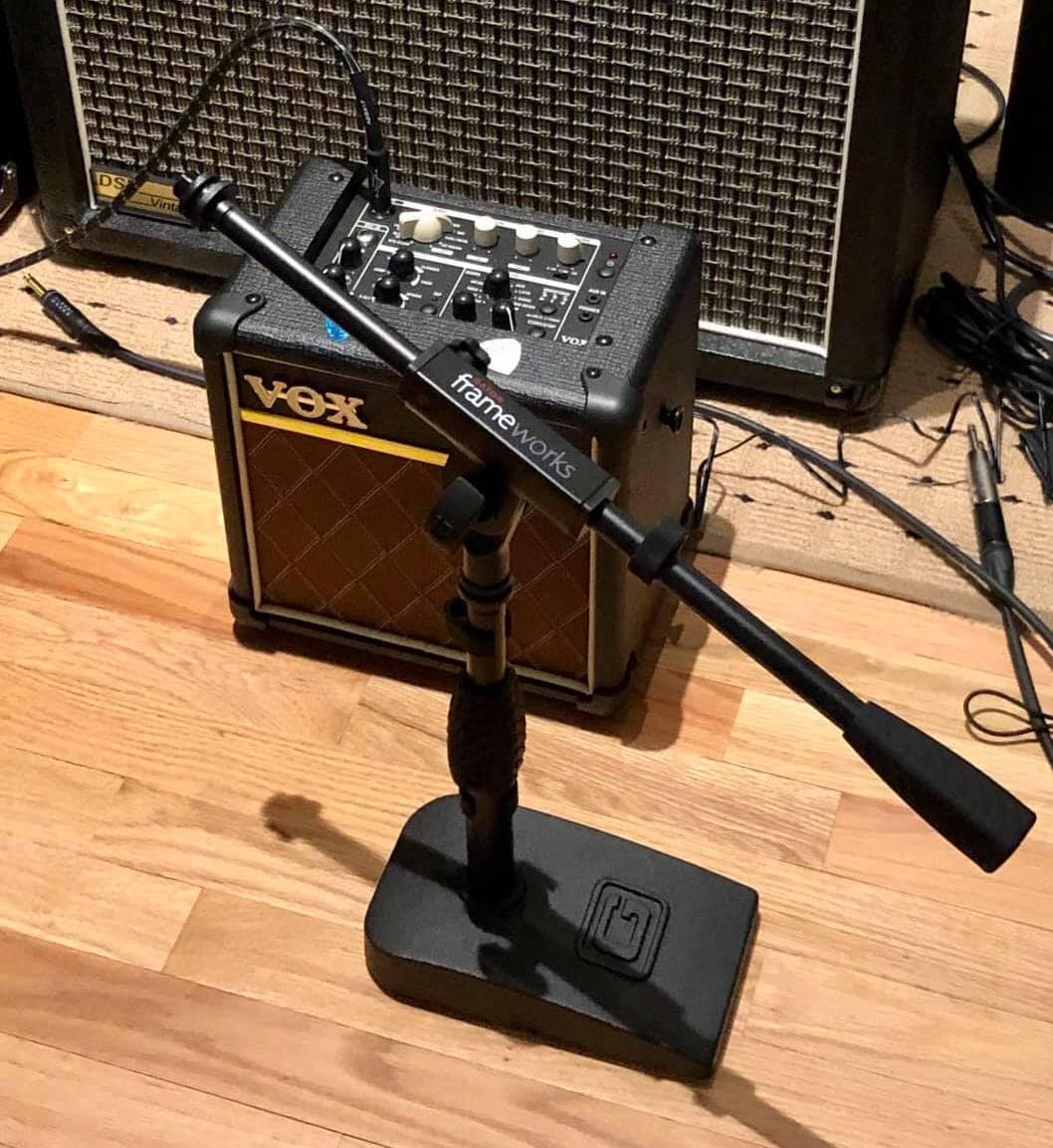
Gator Amp Mic Stand
Believe it or not, I use bass drum stands as desk stands because they're low and have a base. You don't need to screw them onto an edge; they can just sit on top of a keyboard or console. It's an easy way to set up a mic and record some vocal ideas while you're writing.
It's also helpful if you use a vocoder. I use the Behringer VC340, a re-creation of the Roland VP 330, which has an XLR mic input. Sometimes I want to play chords and sing into the vocoder, but I need both hands.
It's also great for doing interviews or podcasts when you want the mic to be close to the person. Just use a bass drum mic stand instead of unscrewing and screwing desk arms everywhere.
If I had to find one thing I don't like about this stand, it's that it doesn't have a round base; it has a rectangular wedge base. I feel like classic round base stands have better weight distribution, so they won't get knocked over.
6. Samson MB1
The Samson MB1 Mini Boom Stand is the solution to the Gator Amp mic stand's issue. It has a tripod, triangular design that distributes the weight evenly in three directions. This makes it less likely to fall over if someone bumps into it, which is crucial for protecting your mic.
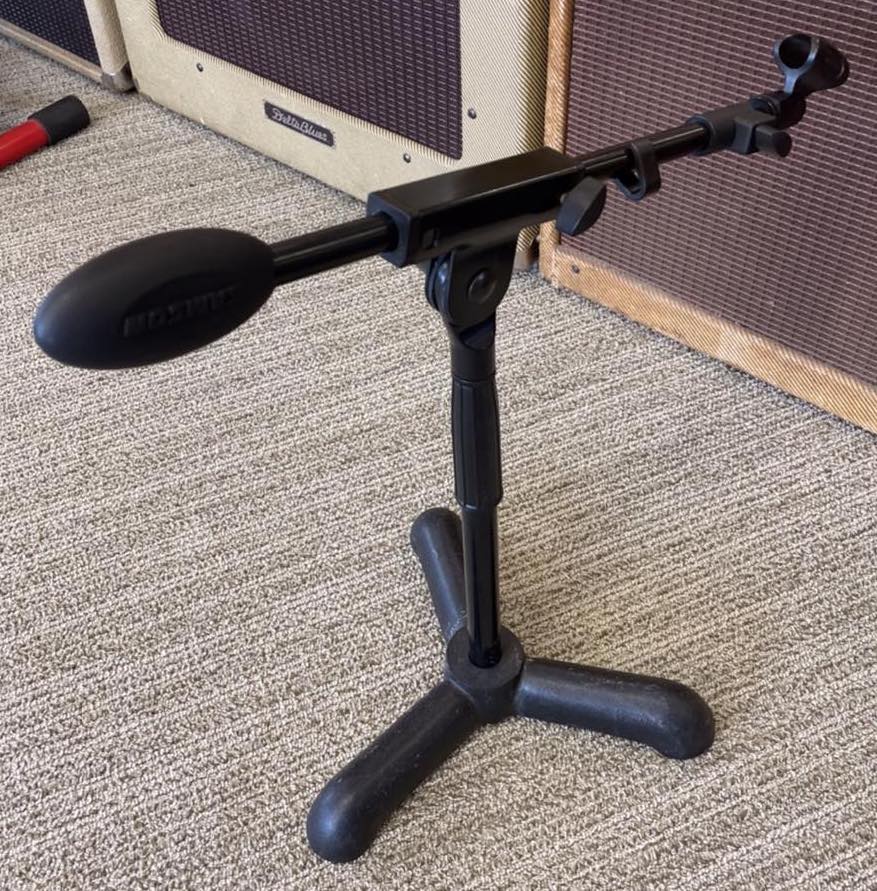
Samson Mini Boom Stand
Sometimes I like to switch things up and use a Neumann U87 mic. It's not your everyday mic for cooking up beats, but I love the lows and highs that the U87 brings to the table. If I decide to use the U87 for a kick drum, I don't want anyone accidentally damaging my expensive mic. That's why this design is perfect for live-tracking situations.
And check this out, the weight anchor at the end of the stand is legit. It's the same kind of anchor you'd find on those fancy orchestral boom stands but adapted for a smaller stand. No more worries about your heavy mic dragging down the boom.
The only downside to this stand is that the tube feels kinda flimsy. It's made of aluminum, which screws onto the base just fine, but I'm not sure how it'll hold up over time with a lot of use. I don't know if this is the kind of quality build I'd expect from a top-notch floor base stand, you know?
7. Heil PL 2T
The Heil PL 2T boom arm is perfect for broadcasting, voiceovers, and podcasting. It's super quiet thanks to the preset internal spring tension that soaks up any movement from the elbow or other parts, making it easy to adjust on the fly during recording.
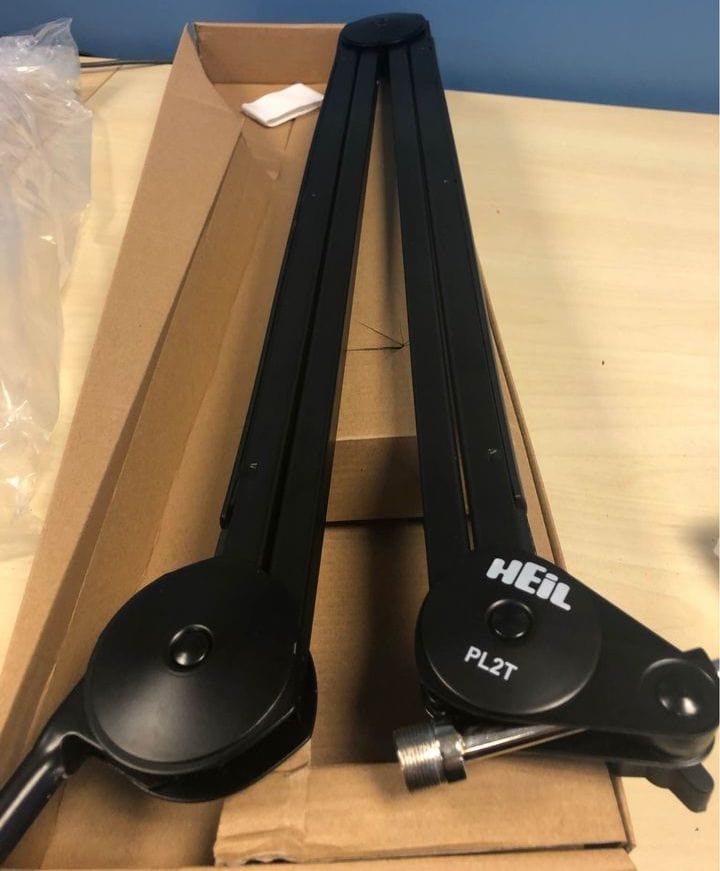
Heil PL 2T
As we already discussed in this article, it's really annoying when someone is talking and they accidentally move the mic, causing terrible noises like screeching or static. It's so distracting and as an engineer, I have to use things like Izotope RX10 afterward to try and fix it. Sometimes it's just not possible to get rid of.
Having a quiet boom arm is essential for podcasting and voiceovers, especially when you're live streaming and there's no chance to fix mistakes. With voiceovers, you can always redo the recording to fix any issues caused by adjusting the mic.
However, the Heil Boom arm looks kind of cheap and its joints and elbows are too stiff. It can be hard work to move it up and down. Personally, I prefer boom arms with a clutch that locks into place, so you can move it around easily and quickly lock it in place. Unfortunately, I don't think the Heil has the best design for that.
Choosing a Boom or Desk Mic Stand
Alright, so after going through all the different models we've talked about, it's obvious that picking the perfect boom or desk arm mic stand all boils down to what you personally need. Are you planning on using it to create songs or are you more of a podcaster/broadcaster who'll be using it mainly for creating content and videos?
No matter what you end up choosing to do, most of these stands are pretty versatile and should work for you. Let's go over a few things you should think about before making your final decision.
Stationary or Portable
So, when you're picking out a stand, the first thing to think about is whether you want something that's fixed to your desk or something that's more portable. Do you need something that you can move around the room with ease? Or are you okay with a stand that's stuck in one spot?
Personally, I like to use a mix of different stands. For making music, I use desktop stands. But for video work, I use Blue Mics with longer arms that I can move around easily.
I don't really need a desk arm that clamps onto the table because I'm not a broadcaster or a podcaster. What you do for work will also play a role in deciding which kind of stand is right for you.
Accessories
To start, you need to decide if you want a stand that attaches to your desk or a portable tripod-style stand. Once you've chosen, consider the accessories that come with it.
For instance, if you go with the desk clamp, make sure it can clip onto any desk you have in mind. Keep in mind that some production desks might be too thick and you don't want to damage an antique desk.
Also, some models come with a cable, while others don't. It's better to provide your own cable, but having one already included is convenient.
Ultimately, the cable choice depends on how you plan to use the stand. If you're recording professional vocals from your desk, then a professional cable is best. But if you're a broadcaster, the XL or included cable is likely good enough.
Build Quality and Design
You definitely want to make sure that the build quality and durability are on point. You don't want to be dealing with a stand that can't hold up the weight of your mic over time; that's just asking for trouble.
So, look for a stand that has a good elbow joint and a solid locking mechanism on the extended arm. That way, you won't have to worry about the weight of your mic causing any issues.
Also, you have to think about the material the stand is made of. Steel stands are usually more durable than aluminum stands and will hold up better over time. Yes, steel stands might cost a bit more, but trust me, it's worth it because they last way longer and give your mic more reliable support.
Closing Thoughts
It's crazy how the little things like mic stands, cables, and other accessories can make such a big difference, huh?
The panelists over at NAMM were saying how nowadays, as musicians, we gotta be marketers too. It's not just about the music anymore, but also about promoting ourselves. Our brand, story, and artistry are all one package.
That's why we spend so much time on digital and social media, and sometimes even make music while doing it. And you know what? Having the right equipment and mic stands in your studio can save you time and keep you motivated, no matter what your music career goals are. Now go crush it!

